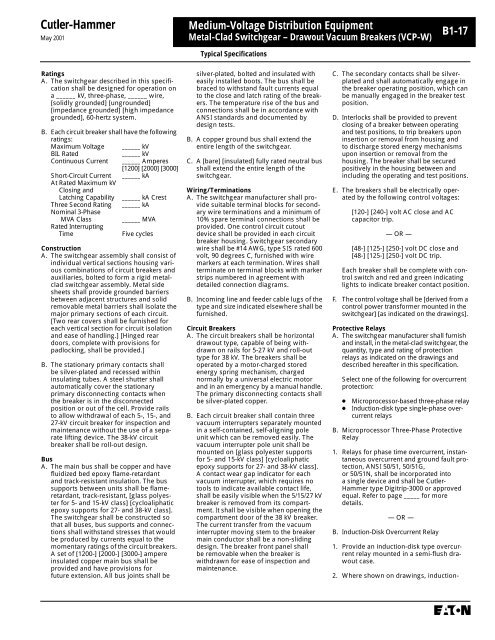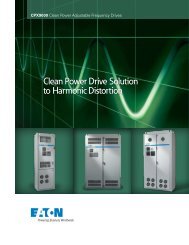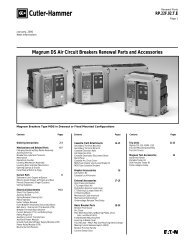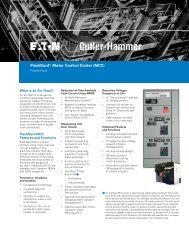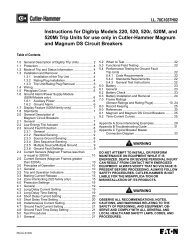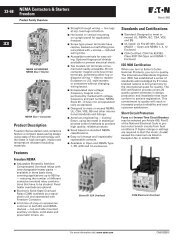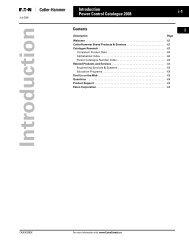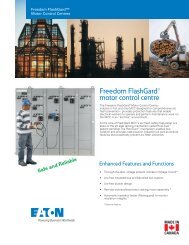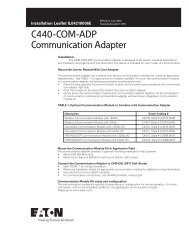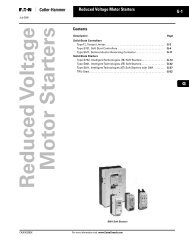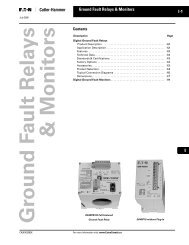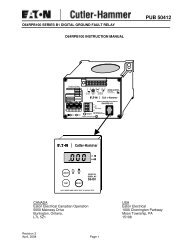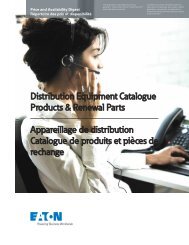Cutler-Hammer - Eaton Canada
Cutler-Hammer - Eaton Canada
Cutler-Hammer - Eaton Canada
You also want an ePaper? Increase the reach of your titles
YUMPU automatically turns print PDFs into web optimized ePapers that Google loves.
<strong>Cutler</strong>-<strong>Hammer</strong><br />
May 2001<br />
Ratings<br />
A. The switchgear described in this specification<br />
shall be designed for operation on<br />
a ______ kV, three-phase, ______ wire,<br />
[solidly grounded] [ungrounded]<br />
[impedance grounded] [high impedance<br />
grounded], 60-hertz system.<br />
B. Each circuit breaker shall have the following<br />
ratings:<br />
Maximum Voltage ______ kV<br />
BIL Rated ______ kV<br />
Continuous Current ______ Amperes<br />
[1200] [2000] [3000]<br />
Short-Circuit Current ______ kA<br />
At Rated Maximum kV<br />
Closing and<br />
Latching Capability ______ kA Crest<br />
Three Second Rating ______ kA<br />
Nominal 3-Phase<br />
MVA Class ______ MVA<br />
Rated Interrupting<br />
Time Five cycles<br />
Construction<br />
A. The switchgear assembly shall consist of<br />
individual vertical sections housing various<br />
combinations of circuit breakers and<br />
auxiliaries, bolted to form a rigid metalclad<br />
switchgear assembly. Metal side<br />
sheets shall provide grounded barriers<br />
between adjacent structures and solid<br />
removable metal barriers shall isolate the<br />
major primary sections of each circuit.<br />
[Two rear covers shall be furnished for<br />
each vertical section for circuit isolation<br />
and ease of handling.] [Hinged rear<br />
doors, complete with provisions for<br />
padlocking, shall be provided.]<br />
B. The stationary primary contacts shall<br />
be silver-plated and recessed within<br />
insulating tubes. A steel shutter shall<br />
automatically cover the stationary<br />
primary disconnecting contacts when<br />
the breaker is in the disconnected<br />
position or out of the cell. Provide rails<br />
to allow withdrawal of each 5-, 15-, and<br />
27-kV circuit breaker for inspection and<br />
maintenance without the use of a separate<br />
lifting device. The 38-kV circuit<br />
breaker shall be roll-out design.<br />
Bus<br />
A. The main bus shall be copper and have<br />
fluidized bed epoxy flame-retardant<br />
and track-resistant insulation. The bus<br />
supports between units shall be flameretardant,<br />
track-resistant, [glass polyester<br />
for 5- and 15-kV class] [cycloaliphatic<br />
epoxy supports for 27- and 38-kV class].<br />
The switchgear shall be constructed so<br />
that all buses, bus supports and connections<br />
shall withstand stresses that would<br />
be produced by currents equal to the<br />
momentary ratings of the circuit breakers.<br />
A set of [1200-] [2000-] [3000-] ampere<br />
insulated copper main bus shall be<br />
provided and have provisions for<br />
future extension. All bus joints shall be<br />
Medium-Voltage Distribution Equipment<br />
Metal-Clad Switchgear – Drawout Vacuum Breakers (VCP-W)<br />
Typical Specifications<br />
silver-plated, bolted and insulated with<br />
easily installed boots. The bus shall be<br />
braced to withstand fault currents equal<br />
to the close and latch rating of the breakers.<br />
The temperature rise of the bus and<br />
connections shall be in accordance with<br />
ANSI standards and documented by<br />
design tests.<br />
B. A copper ground bus shall extend the<br />
entire length of the switchgear.<br />
C. A [bare] [insulated] fully rated neutral bus<br />
shall extend the entire length of the<br />
switchgear.<br />
Wiring/Terminations<br />
A. The switchgear manufacturer shall provide<br />
suitable terminal blocks for secondary<br />
wire terminations and a minimum of<br />
10% spare terminal connections shall be<br />
provided. One control circuit cutout<br />
device shall be provided in each circuit<br />
breaker housing. Switchgear secondary<br />
wire shall be #14 AWG, type SIS rated 600<br />
volt, 90 degrees C, furnished with wire<br />
markers at each termination. Wires shall<br />
terminate on terminal blocks with marker<br />
strips numbered in agreement with<br />
detailed connection diagrams.<br />
B. Incoming line and feeder cable lugs of the<br />
type and size indicated elsewhere shall be<br />
furnished.<br />
Circuit Breakers<br />
A. The circuit breakers shall be horizontal<br />
drawout type, capable of being withdrawn<br />
on rails for 5-27 kV and roll-out<br />
type for 38 kV. The breakers shall be<br />
operated by a motor-charged stored<br />
energy spring mechanism, charged<br />
normally by a universal electric motor<br />
and in an emergency by a manual handle.<br />
The primary disconnecting contacts shall<br />
be silver-plated copper.<br />
B. Each circuit breaker shall contain three<br />
vacuum interrupters separately mounted<br />
in a self-contained, self-aligning pole<br />
unit which can be removed easily. The<br />
vacuum interrupter pole unit shall be<br />
mounted on [glass polyester supports<br />
for 5- and 15-kV class] [cycloaliphatic<br />
epoxy supports for 27- and 38-kV class].<br />
A contact wear gap indicator for each<br />
vacuum interrupter, which requires no<br />
tools to indicate available contact life,<br />
shall be easily visible when the 5/15/27 kV<br />
breaker is removed from its compartment.<br />
It shall be visible when opening the<br />
compartment door of the 38 kV breaker.<br />
The current transfer from the vacuum<br />
interrupter moving stem to the breaker<br />
main conductor shall be a non-sliding<br />
design. The breaker front panel shall<br />
be removable when the breaker is<br />
withdrawn for ease of inspection and<br />
maintenance.<br />
B1-17<br />
C. The secondary contacts shall be silverplated<br />
and shall automatically engage in<br />
the breaker operating position, which can<br />
be manually engaged in the breaker test<br />
position.<br />
D. Interlocks shall be provided to prevent<br />
closing of a breaker between operating<br />
and test positions, to trip breakers upon<br />
insertion or removal from housing and<br />
to discharge stored energy mechanisms<br />
upon insertion or removal from the<br />
housing. The breaker shall be secured<br />
positively in the housing between and<br />
including the operating and test positions.<br />
E. The breakers shall be electrically operated<br />
by the following control voltages:<br />
[120-] [240-] volt AC close and AC<br />
capacitor trip.<br />
— OR —<br />
[48-] [125-] [250-] volt DC close and<br />
[48-] [125-] [250-] volt DC trip.<br />
Each breaker shall be complete with control<br />
switch and red and green indicating<br />
lights to indicate breaker contact position.<br />
F. The control voltage shall be [derived from a<br />
control power transformer mounted in the<br />
switchgear] [as indicated on the drawings].<br />
Protective Relays<br />
A. The switchgear manufacturer shall furnish<br />
and install, in the metal-clad switchgear, the<br />
quantity, type and rating of protection<br />
relays as indicated on the drawings and<br />
described hereafter in this specification.<br />
Select one of the following for overcurrent<br />
protection:<br />
● Microprocessor-based three-phase relay<br />
● Induction-disk type single-phase overcurrent<br />
relays<br />
B. Microprocessor Three-Phase Protective<br />
Relay<br />
1. Relays for phase time overcurrent, instantaneous<br />
overcurrent and ground fault protection,<br />
ANSI 50/51, 50/51G,<br />
or 50/51N, shall be incorporated into<br />
a single device and shall be <strong>Cutler</strong>-<br />
<strong>Hammer</strong> type Digitrip-3000 or approved<br />
equal. Refer to page _____ for more<br />
details.<br />
— OR —<br />
B. Induction-Disk Overcurrent Relay<br />
1. Provide an induction-disk type overcurrent<br />
relay mounted in a semi-flush drawout<br />
case.<br />
2. Where shown on drawings, induction-


